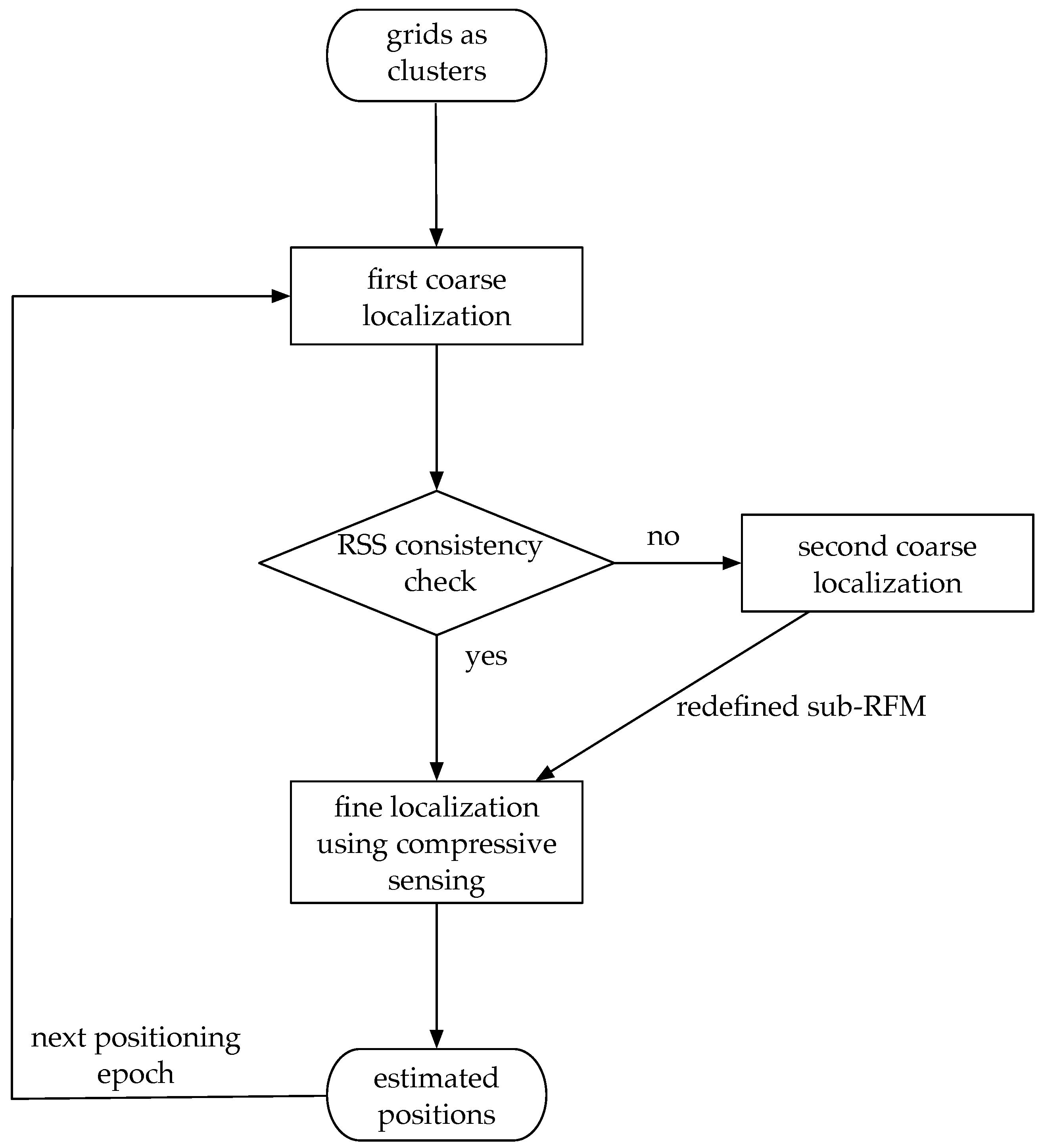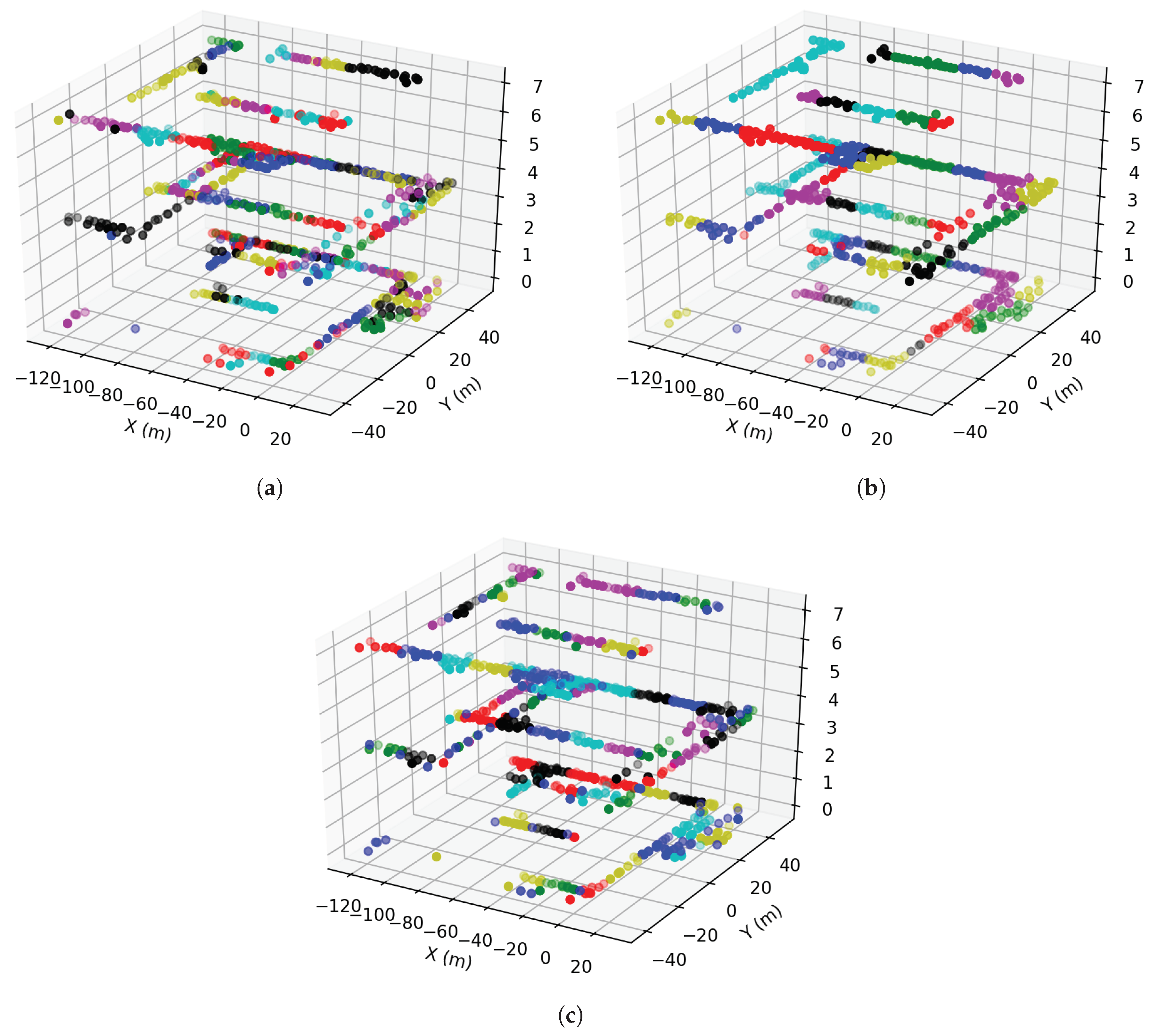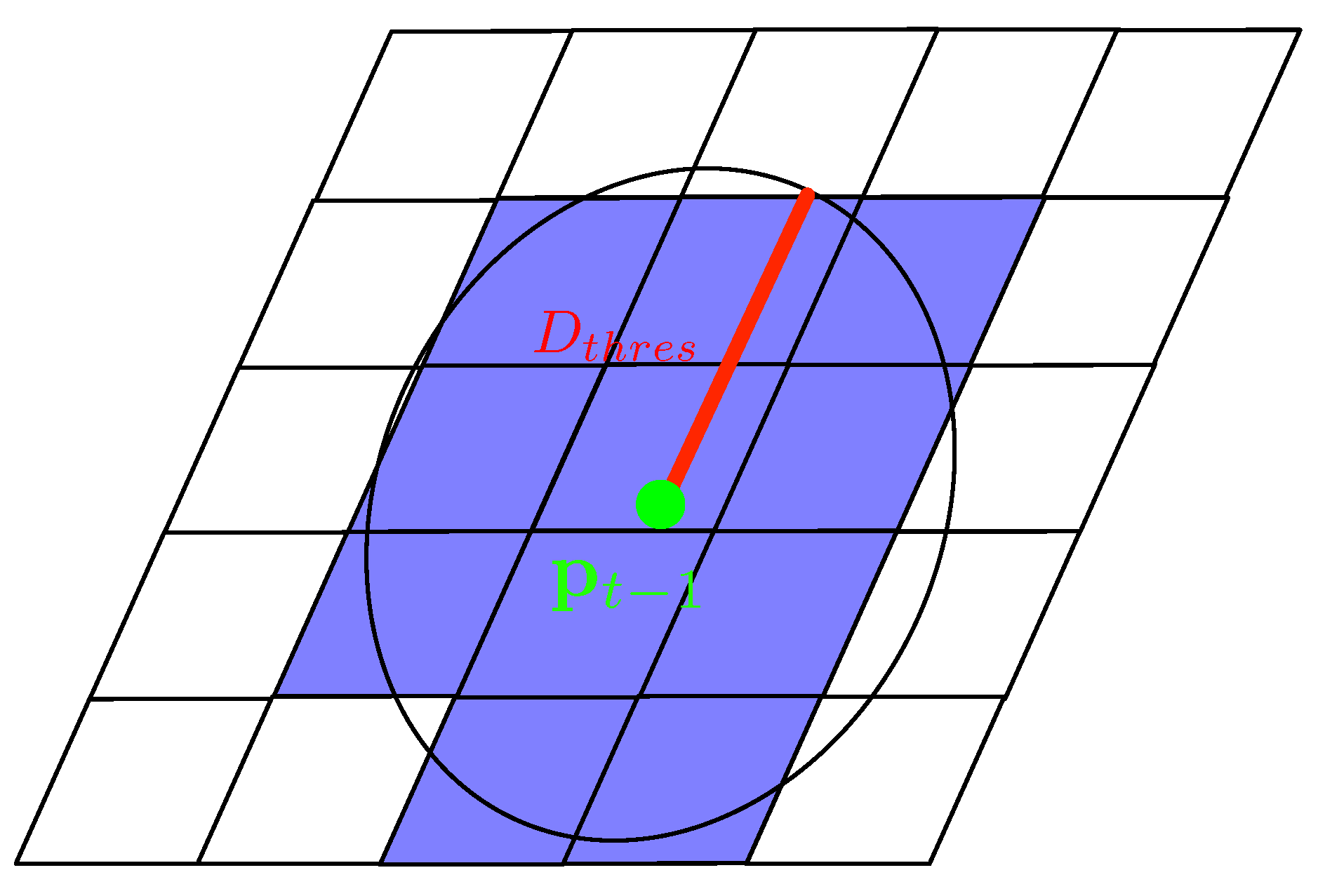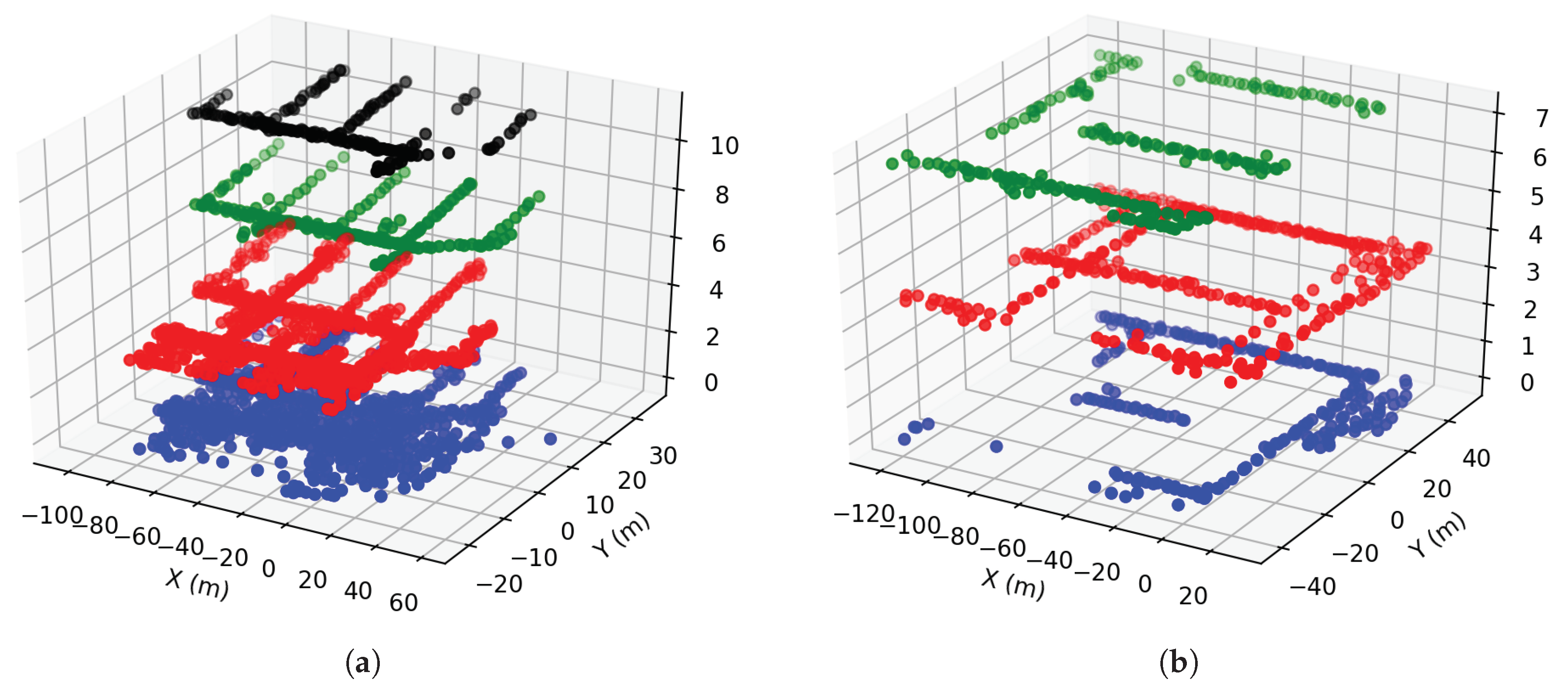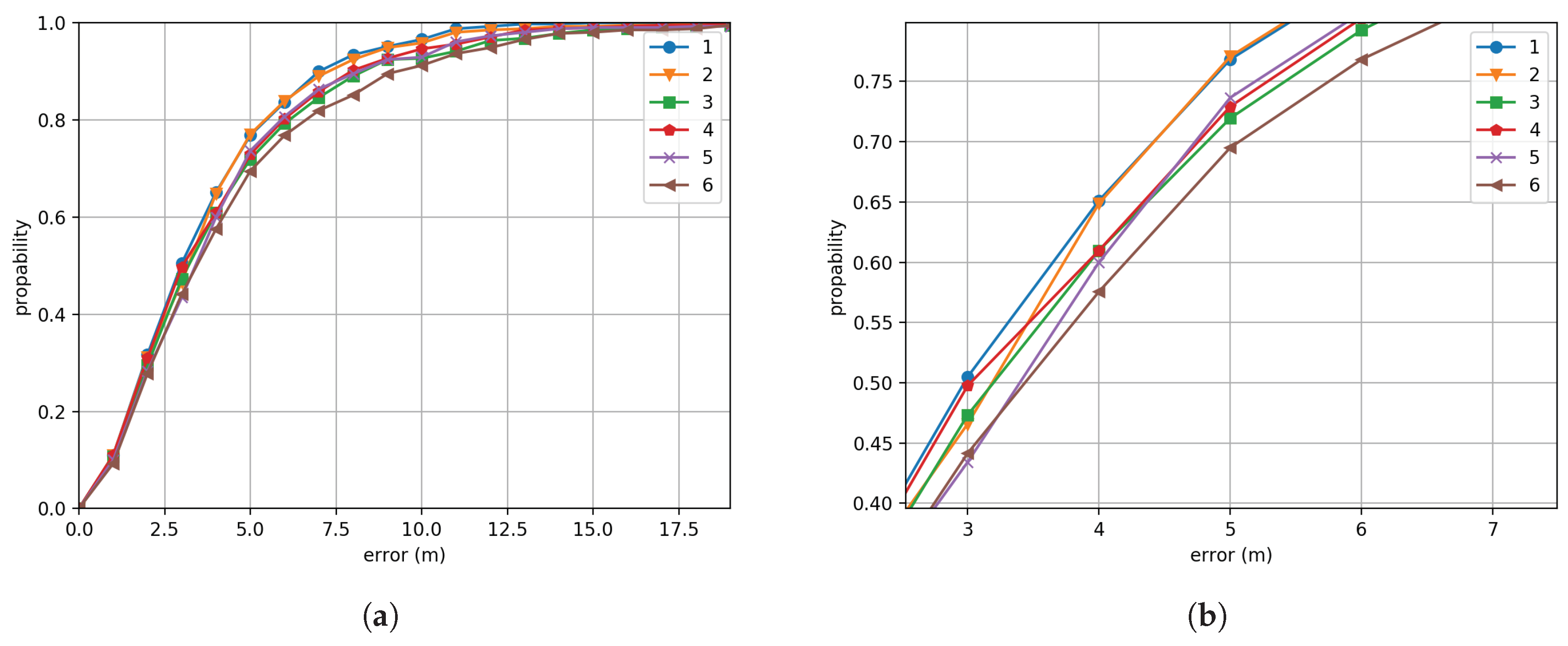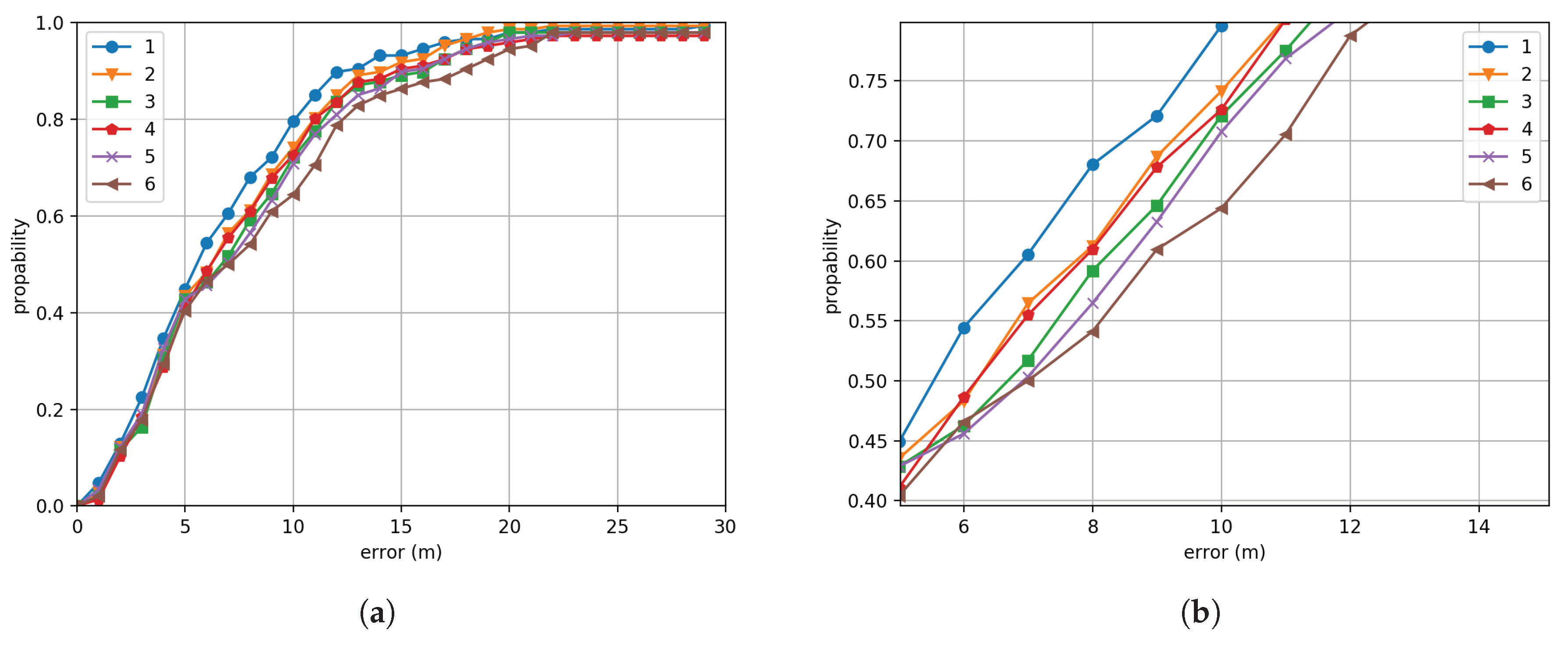1. Introduction
Location is the basis for a large amount of smart applications, e.g., location-based service (LBS). However, as the signals from global positioning system (GPS) are generally blocked or existing severe multi-path in the indoor environment, satellite-based positioning fails to work efficiently indoors. A bunch of positioning methods can be adopted instead for the indoor environment, for example, ultra wide band (UWB)-based [
1], radio frequency identification (RFID)-based [
2], ultra sound-based [
3], bluetooth low energy (BLE)-based [
4], wireless local area network (WLAN)-based [
5,
6] and so on. Among the many existing indoor positioning methods, WLAN-based positioning has great potential for practical applications for the following three reasons:
WLAN-based positioning relies on existing access points (APs) commonly seen in many public indoor environments, while many others rely on pre-install infrastructures and are not cost efficient for large scale usage.
WLAN-based positioning does not ask for extra hardwares on the user side. The user can locate themselves with only a commonly seen WLAN-enabled devices.
The users can help improve the positioning accuracy by contributing their collected data, thus, making the positioning system organic [
7].
Currently, most WLAN-based positioning adopt the fingerprinting-based two stage positioning flow [
8]. The first phase is the training phase and the second phase is the positioning phase. In the first phase, the received signal strength (RSS) from different APs (also denoted as RSS fingerprints) are collected at some reference points (RPs) in the positioning area. These RSS fingerprints along with known positions are adopted to build a reference fingerprint map (RFM), also denoted as radio map (RM). In the second phase, after the RFM is ready, the newly collected fingerprints from users equipped with smart devices are compared against the fingerprints in the RFM to estimate the users’ or devices’ positions. The underlying assumption for fingerprinting-based WLAN positioning is that the vicinity relationship is kept across fingerprint space (signal space) and 3D space (coordinate space) [
8]. From this point of view, the positioning phase is essentially finding similar fingerprints so that the corresponding 3D positions can be adopted as estimations for the users’ locations.
The principle for positioning is simple, however, many factors should be taken into account in designing the positioning method in practical applications. Two major considerations are:
Scalability. In real scenario applications, the RFM can be very large in RP number and can across different floors. After the new RSS fingerprint is collected, it may take a long time to search for the matching fingerprint in the RFM. The latency in positioning can render the positioning results unusable. Therefore, the positioning method should be robust to the scalability of the RFM.
Accuracy. This is a common consideration for different positioning systems. In WLAN-based positioning, itis preferable that the results are accurate in 3-D position estimation including the floor number and the horizontal position estimations.
A commonly seen WLAN positioning framework considering the mentioned two factors is to cluster in the training phase and to partition the positioning phase into coarse localization and fine localization. The framework can also be denoted as hierarchical positioning. As shown in
Figure 1, in the training phase the fingerprints are clustered into small batches. For each of the clusters, a cluster center or examplar is formed. In the positioning phase, the newly collected fingerprint is firstly compared with the cluster centers (cluster matching) to find some potential clusters the fingerprint belong (coarse localization). Then, all fingerprints within the potential clusters are extracted to form a sub-RFM. The fine positioning is carried out adopting the sub-RFM. As the number of fingerprints in the sub-RFM is generally much smaller than that of the whole RFM, the searching/matching time is substantially shortened. Therefore, the clustering-positioning implementation have solved the scalability problem. In addition, as the coarse localization can narrow the searching range and thus, can get rid of some wanted outliers, the localization accuracy can generally be improved [
9].
There are many methods adopting the clustering-positioning implementation. Through the different domains, the clustering is carried out, these methods can be partitioned into two categories: RSS clustering and 3D clustering [
10]. For the 3D clustering category, the clustering is carried out in the coordinate space, where the fingerprints collected in nearby positions are considered as a cluster. In [
10,
11], the 3D clustering is carried out using k-means clustering. The previous estimated position can be adopted to find out the potential clusters in the coarse localization. In this way, the prior information for localization is adopted, which implies that users’ positions is somewhat continuous. However, a problem is raised here that large errors from current estimation will affect the accuracy of subsequent estimates because the potential clusters may be stuck in a small area. This is solved in [
10] by adding a global search process if the newly collected fingerprints are significantly different from those in the potential clusters. This can greatly improve the positioning accuracy, however, global search may introduce significant latency. In the RSS clustering category, the clusters are generated though clustering in the RSS space. Different clustering strategy is adopted in different methods, such as k-mean, affinity propagation in [
12,
13]. Generally, affinity propagation works better than k-means for RSS clustering and no prior cluster numbers are needed. Affinity propagation creates clusters by sending messages between pairs of samples until convergence [
14]. After RSS clustering, there are also different methods in coarse localization and fine localization. For example, kNN [
15], kernel based [
16] and compressive sensing-based [
17,
18]. Among them, compressive sensing-based methods are reported to have better accuracy than the other two. However, as this type of methods normally overlook the information provided by adjacent position estimations, the accuracy is reported to be worse than 3D clustering [
10].
Table 1 shows the respective comparisons of 3D clustering and RSS clustering. In summery, the 3D clustering has better positioning accuracy than the RSS clustering because prior position information is adopted. RSS clustering is better than 3D clustering in terms of robustness because 3D clustering may break the hierarchical positioning structure once in a while and having unstable latencies.
An improved hierarchical WLAN positioning method is proposed in this paper. The method can combine the advantages of traditional 3-D clustering and RSS clustering. The existing RFM is firstly partitioned into fixed size grids as clusters, which can avoid the exhaustive clustering process. Then in the coarse localization phase, the previously estimated position is adopted to find the potential clusters as sub-RFM. If the modified Jaccard distance between the newly collected fingerprint and the sub-RFM is over a threshold, the sub-RFM is defined again by RSS fingerprint matching adopting the mentioned Jaccard distance. Finally, in the fine localization phase, the compressive sensing theory is adopted to increase the positioning accuracy.
Figure 2 shows the overall structure of the proposed method. It should be noted that the proposed method has adopted the information from previously estimated positions and can avoid global fingerprint matching. The overall structure is only simply introduced here. More details will be introduced in the Method section. Experiments are carried out and show that the proposed method is better than many existing methods in terms of accuracy.
5. Conclusions and Discussions
Hierarchical-based positioning partitions the WLAN positioning into coarse localization phase and fine localization phase, and can efficiently decrease the positioning latency, and even improve the positioning accuracy. For the coarse localization phase, two different strategies can be adopted to provide the necessary clusters: RSS clustering and 3D clustering. For the fine localization phase, different positioning algorithms can be adopted, such as compressive sensing, kernel based and simple kNN. This paper have studied the different combinations of the mentioned clustering strategies and positioning algorithms. The paper proposed a novel hierarchical WLAN positioning method with the 3D clustering + compressive sensing combination. The method adopts grid-based clustering and the modified Jaccard distance metric in the first coarse localization phase. To avoid wrong sub-RFM extraction, an RSS consistency check is carried out and then performs the second coarse localization if not passed. At last, the compressive sensing theory is adopted in the fine localization phase. With these procedures, the proposed method can avoid the stuck-in-small-area problem commonly seen in traditional 3D clustering methods. With the experiments carried out, this combination is proved to be more accurate than the traditional 3D clustering method in [
10] and the traditional compressive sensing-based method in [
17]. Moreover, for the aspect of positioning latency, the proposed method is proved to be more robust than the traditional 3D clustering-based method in [
10]. What should be noted here is that the accuracy improvement by adopting compressive sensing over kNN and kernel-based methods is sometimes not so significant, and the extent of accuracy improvement differs over different datasets.
The reasons why the accuracy is superior to [
10,
17] are two folds:
Also, the proposed method can avoid larger positioning latencies in [
10]. This is due to the fact that the second coarse localization phase is added if the RSS consistency check is not passed. The positioning is degenerating to the situation where the mentioned prior information is not available. This is different from the strategy in [
10], where global fingerprint matching is conducted when similar situations are encountered.

